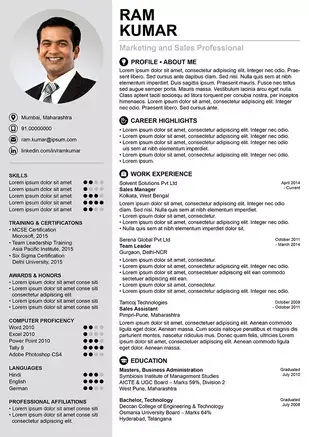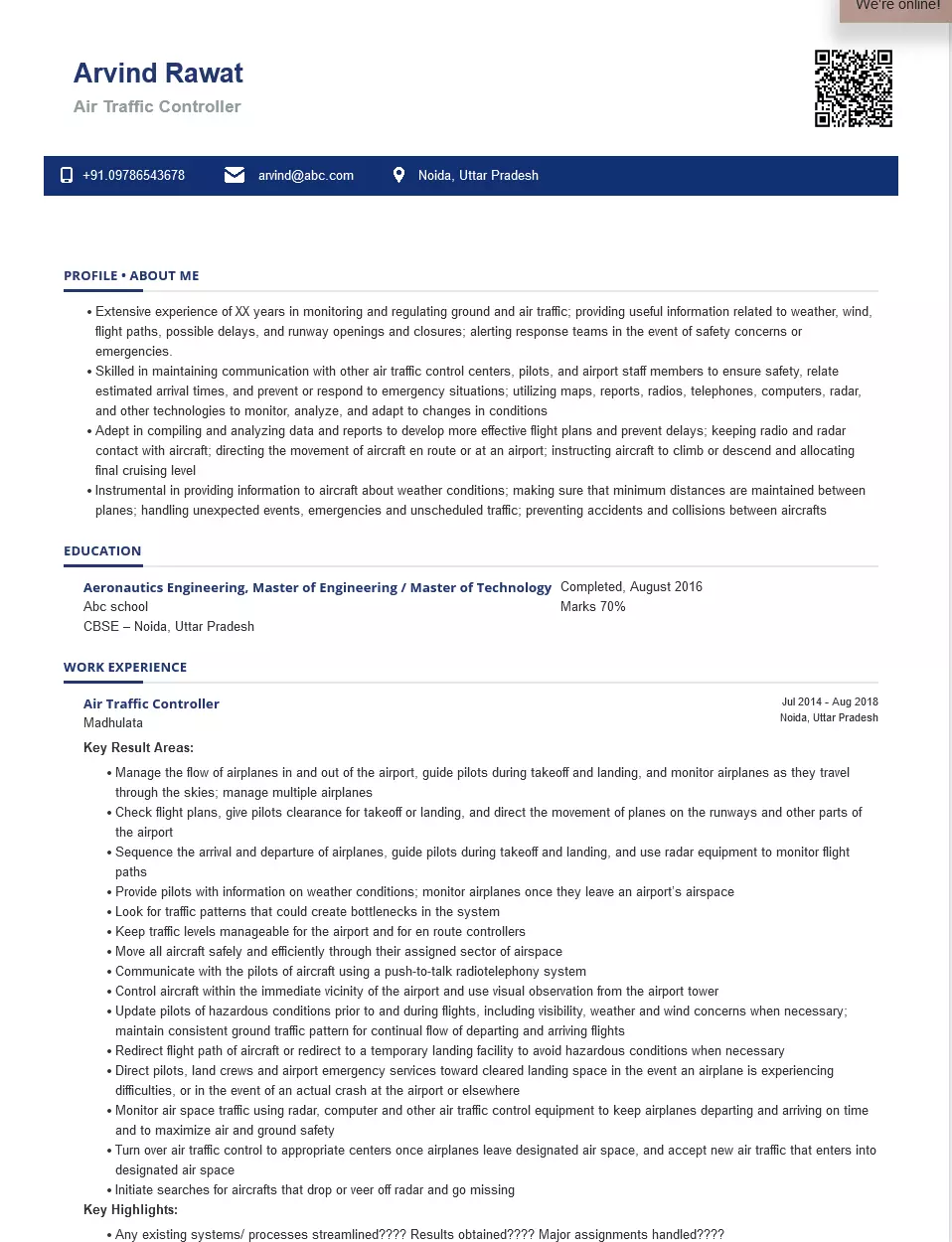- Certified CPR, AED, and first-aid, Completed , January 2016
What's your job?
Air Traffic Controller Resume Samples and Templates for 2026
- Table of Contents
- Downloadable Sample
- Resume Tips from Experts
- Resume Text Version
- Share
Air Traffic Controller Resume Guide for India
A well-crafted air traffic controller resume is essential for success in India’s growing civil aviation sector. Whether you’re a fresher preparing for AAI (Airports Authority of India) recruitment or an experienced professional seeking advancement at major airports like Delhi, Mumbai, or Bangalore, this guide provides everything you need to create a standout resume.
This comprehensive guide includes:
- Resume format recommendations for India
- Key skills Indian aviation employers look for
- Complete resume example with Indian context
- AAI and aviation employer information
- Salary insights in INR by experience level
- Training and certification guidance
- ATS optimization tips for Indian applications
Why Your Air Traffic Controller Resume Matters in India
India’s civil aviation sector is one of the fastest-growing globally, with AAI managing over 130 airports. The Airports Authority of India (AAI), Indian Air Force (IAF), and private airport operators actively recruit skilled controllers. A strong resume helps you:
- Stand out in competitive AAI recruitment processes
- Showcase skills that Indian aviation employers value
- Demonstrate your expertise in air traffic management
- Present your qualifications for ATC examinations and interviews
Indian aviation recruiters value precision, decision-making ability, and communication skills. Your resume must immediately communicate your training, certifications, and aptitude for this safety-critical role.
Air Traffic Controller Resume Format for India
Government and aviation employers prefer clean, professional resume formats. Here’s what works best:
Recommended Format
- Length: 1-2 pages (freshers: 1 page, experienced: 2 pages max)
- Layout: Reverse chronological (most recent first)
- Font: Clean fonts like Calibri or Arial (11-12pt)
- Sections: Contact, Summary, Skills, Experience, Education, Training
Professional Presentation
Your resume should reflect the precision and attention to detail critical in ATC.
Personal Details for Indian ATC Resumes
Include:
- Full name
- Phone number with country code (+91)
- Professional email address
- City, State (full address not required)
- Date of Birth (required for government applications)
What to Avoid
- Complex formatting
- Personal information like religion or caste
- Salary expectations
- References (provide when requested)
Key Skills for Air Traffic Controllers in India
Indian aviation employers look for specific technical and operational capabilities.
Core ATC Skills
- Air Traffic Management: Separation, sequencing, flow control
- Radar Operations: Primary and secondary surveillance radar
- Communication: R/T phraseology, pilot coordination
- Navigation: Airways, procedures, airspace management
- Weather Assessment: METAR, TAF interpretation
- Emergency Handling: Distress, urgency procedures
- Coordination: Inter-ATC, approach, tower coordination
Technical Skills
- Radar systems and displays
- Flight data processing systems
- Voice communication systems
- Radio telephony equipment
- Meteorological displays
- Automation systems
- CPDLC (Controller-Pilot Data Link)
Regulatory Knowledge
- DGCA regulations and procedures
- ICAO standards and recommended practices
- Indian Air Navigation Orders
- Aeronautical Information Publications (AIP India)
- NOTAM interpretation
- Airspace classification
- Emergency and contingency procedures
Soft Skills Valued
- Situational Awareness: Continuous monitoring
- Decision-Making: Quick, accurate judgments
- Stress Management: High-pressure handling
- Communication: Clear, concise R/T
- Teamwork: Shift coordination
How to Present Skills
List ratings and endorsements prominently. Mention specific airports and traffic volumes. Include language proficiency.
Air Traffic Controller Resume Example for India
Here’s a complete resume example for Indian ATC professionals:
Arvind Shankar
Chennai, Tamil Nadu | +91-98XXX-XXXXX | arvind.atc@email.com
Date of Birth: 15 March 1990
Professional Summary
Experienced Air Traffic Controller with 8+ years of service at AAI handling over 400 aircraft movements daily. Currently posted at Chennai International Airport (MAA) with Aerodrome Control, Approach Control, and Area Control ratings. ICAO English Level 5 proficient with expertise in radar vectoring, arrival/departure sequencing, and emergency handling. Zero separation violations in career with commendation for safe handling of engine failure emergency.
Key Skills
Aerodrome Control | Approach Radar | Area Control | R/T Communication | Radar Vectoring | Traffic Sequencing | Weather Assessment | Emergency Procedures | ICAO Standards | Coordination
Professional Experience
Air Traffic Controller (Senior) | Airports Authority of India | Chennai | April 2019 – Present
- Handle 400+ daily movements at Chennai International Airport
- Operate Tower, Approach, and Area Control positions
- Manage arrivals and departures on parallel runways
- Coordinate with military ATC for airspace management
- Handle weather diversions and emergency situations
- Train junior controllers as On-the-Job Training Instructor
- Maintain 100% separation compliance record
- Participate in airport emergency exercises
Ratings Held:
- Aerodrome Control Rating (ADC)
- Approach Control Procedural Rating (APP)
- Approach Control Surveillance Rating (APS)
- Area Control Procedural Rating (ACP)
Traffic Volumes Handled:
- Peak Hour: 35+ movements
- Daily Average: 400+ movements
- Annual: 140,000+ movements
Air Traffic Controller | AAI | Jaipur | June 2015 – March 2019
- Controlled traffic at Jaipur International Airport
- Handled mixed traffic including civil and military
- Achieved ADC and APP ratings
- Managed seasonal traffic surges during tourist season
- Coordinated with IAF for restricted airspace
- Zero incidents during tenure
Junior Air Traffic Controller | AAI | Lucknow | July 2013 – May 2015
- Started ATC career at Lucknow Airport
- Completed on-the-job training
- Achieved initial ADC rating
- Learned tower control procedures
- Handled VIP movements and special operations
ATC Ratings & Endorsements
- Aerodrome Control Rating (ADC) | AAI | 2014
- Approach Procedural Rating (APP) | AAI | 2016
- Approach Surveillance Rating (APS) | AAI | 2018
- Area Control Procedural Rating (ACP) | AAI | 2020
- On-the-Job Training Instructor | AAI | 2021
Education
B.Tech (Electronics & Communication) | Anna University | 2013
- First Class with Distinction
- Project: Aviation Communication Systems
Higher Secondary (12th) | CBSE Board | 2009
- Physics, Chemistry, Mathematics
- 89%
Training
Initial ATC Training | Civil Aviation Training College (CATC), Allahabad | 2013
- 1-year residential training program
- Aerodrome and Approach Control
- ICAO standards and procedures
- Passed with First Class
Advanced Radar Training | CATC Hyderabad | 2017
- Approach Surveillance techniques
- Radar vectoring and sequencing
Area Control Training | CATC Allahabad | 2019
- En-route control procedures
- Oceanic procedures basics
Recurrent Training
- Annual refresher training (current)
- Emergency procedures training
- Language proficiency assessment
Language Proficiency
- ICAO English: Level 5 (Extended)
- Hindi: Native
- Tamil: Fluent
- English: Fluent
Medical
- Class 3 Medical Certificate (Current)
- Valid till: December 2025
Achievements
- Commendation for safe handling of B737 engine failure emergency (2022)
- Zero separation violations in 8-year career
- Best Trainee Award at CATC Allahabad (2013)
- Trained 15+ junior controllers as OJTI
- Participated in 5 airport emergency exercises
Technical Proficiency
- Radar: Primary/Secondary Surveillance Radar, MSSR
- Systems: FDPS, AMSS, VCCS
- Communication: VHF, HF, CPDLC basics
- Tools: AIP, NOTAM systems, weather displays
Declaration
I hereby declare that the information provided above is true to the best of my knowledge.
Arvind Shankar Chennai, December 2024
AAI and Aviation Employers in India
India’s ATC sector offers career opportunities:
Primary Employer
- Airports Authority of India (AAI): Main employer
- Manages 130+ airports
- Provides ATC services nationwide
- Offers structured career progression
AAI Recruitment Process
- Eligibility: B.E./B.Tech with 60%+ or equivalent
- Age: 18-27 years (relaxation for reserved categories)
- Selection: Written test, FEAST, Interview, Medical
- Training: CATC Allahabad/Hyderabad
Other Opportunities
- Indian Air Force: Military ATC
- Indian Navy: Naval ATC
- DGCA: Regulatory roles
- Private Airports: GMR, GVK facilities
Major Airports for ATC
- Delhi IGI Airport (DEL)
- Mumbai CSIA (BOM)
- Bangalore KIA (BLR)
- Chennai MAA (MAA)
- Hyderabad RGI (HYD)
- Kolkata NSC (CCU)
Career Progression at AAI
- Junior Executive (ATC)
- Executive (ATC)
- Manager (ATC)
- Senior Manager (ATC)
- General Manager (ATC)
Air Traffic Controller Salary in India
AAI follows government pay scales with additional allowances.
Salary by Grade (AAI)
| Position | Monthly Salary (INR) |
|---|---|
| Junior Executive (Entry) | ₹50,000 - ₹70,000 |
| Executive (3-7 years) | ₹70,000 - ₹1,00,000 |
| Manager (8-15 years) | ₹1,00,000 - ₹1,50,000 |
| Senior Manager (15-20 years) | ₹1,50,000 - ₹2,00,000 |
| General Manager (20+ years) | ₹2,00,000 - ₹2,50,000+ |
Note: Includes basic pay + DA + ATC allowance + other benefits.
Additional Allowances
- ATC Allowance: ₹10,000 - ₹25,000/month
- Night Duty Allowance: For shifts
- Transport Allowance: Shift timings
- HRA: Location-based (30-40%)
- City Compensatory Allowance: Metro cities
Other Benefits
- Pension: NPS contributions
- Medical: CGHS/AAI medical facilities
- Leave: Generous leave policy
- Quarters: Subsidized housing
- LTC: Leave Travel Concession
Salary by Airport Type
| Airport Category | Salary Range |
|---|---|
| Metro (DEL, BOM, BLR) | ₹80,000 - ₹1,50,000/month |
| Major (MAA, HYD, CCU) | ₹70,000 - ₹1,30,000/month |
| Other Airports | ₹60,000 - ₹1,10,000/month |
Salary data based on AAI pay scales and government notifications.
Training and Certification Requirements
ATC requires specialized training and certification.
Initial Training (CATC)
- Duration: 1 year
- Location: CATC Allahabad or Hyderabad
- Content: ATC procedures, simulator training, OJT
- Passing: Minimum 60% in all subjects
Ratings Required
- Aerodrome Control (ADC): Tower operations
- Approach Control Procedural (APP): Non-radar approach
- Approach Control Surveillance (APS): Radar approach
- Area Control Procedural (ACP): En-route control
- Area Control Surveillance (ACS): Radar en-route
Language Proficiency
- ICAO English Level 4 minimum
- Level 5 or 6 for career advancement
- Renewal every 3 years (Level 4) or 6 years (Level 5)
Medical Requirements
- Class 3 Medical Certificate
- Renewed annually after age 40
- Vision, hearing, and cardiovascular standards
Educational Requirements
- B.E./B.Tech (Electronics/Communication/IT) preferred
- Physics + Mathematics in 12th
- 60% aggregate marks
ATS Tips for Your Air Traffic Controller Resume
Aviation employers use systematic screening:
For AAI Applications
- Follow prescribed format if specified
- Include all required details
- List ratings and endorsements clearly
- Mention training and medical status
For Online Applications
- Use clean formatting
- Include exact qualifications
- List ratings systematically
- Upload in .pdf format
General Tips
- DO: List all ratings and endorsements
- DO: Include traffic volumes handled
- DO: Mention language proficiency levels
- DO: Show training and medical currency
- DON’T: Use complex formatting
- DON’T: Omit required information
Keyword Strategy
Common keywords include:
- Air traffic controller, ATC, AAI
- Aerodrome control, approach control, area control
- Radar, surveillance, separation
- ICAO, DGCA, aviation safety
- Chennai airport, Delhi airport
Final Tips for Your Air Traffic Controller Resume
✅ Show ratings: List all ATC ratings held
✅ Include traffic volumes: Daily/annual movements
✅ Mention airports: Specific facilities served
✅ Show training: CATC and refresher training
✅ Medical currency: Valid Class 3 medical
✅ Language proficiency: ICAO English level
Quick Checklist
- Contact information with +91 phone number
- Date of birth (required for government)
- Professional summary highlights ratings and experience
- Skills section includes ATC-specific capabilities
- Experience shows airports and traffic volumes
- All ratings and endorsements listed
- Training from CATC documented
- Medical and language currency shown
- Length is appropriate (1-2 pages)
Ready to create your professional air traffic controller resume? Use our resume builder to get started with templates optimized for aviation roles.
Looking for more guidance? Check out our resume format guide for additional tips on structuring your ATC resume for Indian aviation employers.
Air Traffic Controller Text-Only Resume Templates and Samples
Arvind Rawat
Phone: 09786543678
Email: arvind@abc.com
Address: Alpha1 greater noida, Beta 2 greater noida, Noida
About Me
Air Traffic Controller
- Reliable Air traffic Controller with XX years of experience in monitoring and regulating ground and air traffic. Adept in compiling and analyzing data and reports to develop more effective flight plans and prevent delays; keeping radio and radar contact with aircraft.
- Skilled in maintaining communication with other air traffic control centers, pilots, and airport staff members to ensure safety, relate estimated arrival times, and prevent or respond to emergency situations; utilizing maps, reports, radios, telephones, computers, radar, and other technologies to monitor, analyze, and adapt to changes in conditions
- Adept in compiling and analyzing data and reports to develop more effective flight plans and prevent delays; keeping radio and radar contact with aircraft; directing the movement of aircraft en route or at an airport; instructing aircraft to climb or descend and allocating final cruising level
- Instrumental in providing information to aircraft about weather conditions; making sure that minimum distances are maintained between planes; handling unexpected events, emergencies, and unscheduled traffic; preventing accidents and collisions between aircraft
Education
Aeronautics, Master of Engineering / Master of Technology, Completed, August 2016
Abc school
Delhi University
Noida, UP
Certifications
Work Experience
Period: July 2014 - Current
Air Traffic Controller / En Route controllers
TE International
- Checked flight plans, give pilots clearance for take-off or landing, and direct the movement of planes on the runways and other parts of the airport.
- Communicated with the pilots of aircraft using a push-to-talk radiotelephony system.
- Sequenced the arrival and departure of airplanes, guide pilots during take-off and landing, and use radar equipment to monitor flight paths.
- Moved all aircraft safely and efficiently through their assigned sector of airspace.
- Updated pilots on hazardous conditions prior to and during flights, including visibility, weather, and wind concerns when necessary.
- Controlled aircraft within the immediate vicinity of the airport and used visual observation from the airport tower.
Period: October 1989 - November 2013
Air Traffic Controller
MA Solutions.
- Managed the flow of airplanes in and out of the airport, guide pilots during takeoff and landing, and monitor airplanes as they travel through the skies; manage multiple airplanes.
- Provided pilots with information on weather conditions; monitor airplanes once they leave an airport’s airspace.
- Redirected the flight path of the aircraft or redirect to a temporary landing facility to avoid hazardous conditions when necessary.
- Kept traffic levels manageable for the airport and for en-route controllers.
- Maintained consistent ground traffic patterns for a continual flow of departing and arriving flights.
- Monitored air space traffic using radar, computer, and other air traffic control equipment to keep airplanes departing and arriving on time and maximize air and ground safety.
Skills
Hard Skills
- Radar terminal Display System (RTDS)
- Ground Traffic Control
- National Security Regulations
- Fluency in Air Traffic Control (ATC) software
- Oxygen and aircraft Utility Systems
- Basic Print Reading Skills and Layout Skills
- Three-dimensional situation awareness
- Team-building and supervision
Soft Skills
- Attention to detail
- Visual problem-solving
- Ability to excel under pressure
- Leadership abilities
- Time management
- Decision-making
- Multitasking
Languages
Softwares
Operating System
Personal Interests
- Travelling
- Yoga
- Sports
- Internet Surfing
 India's
premier resume service
India's
premier resume service





